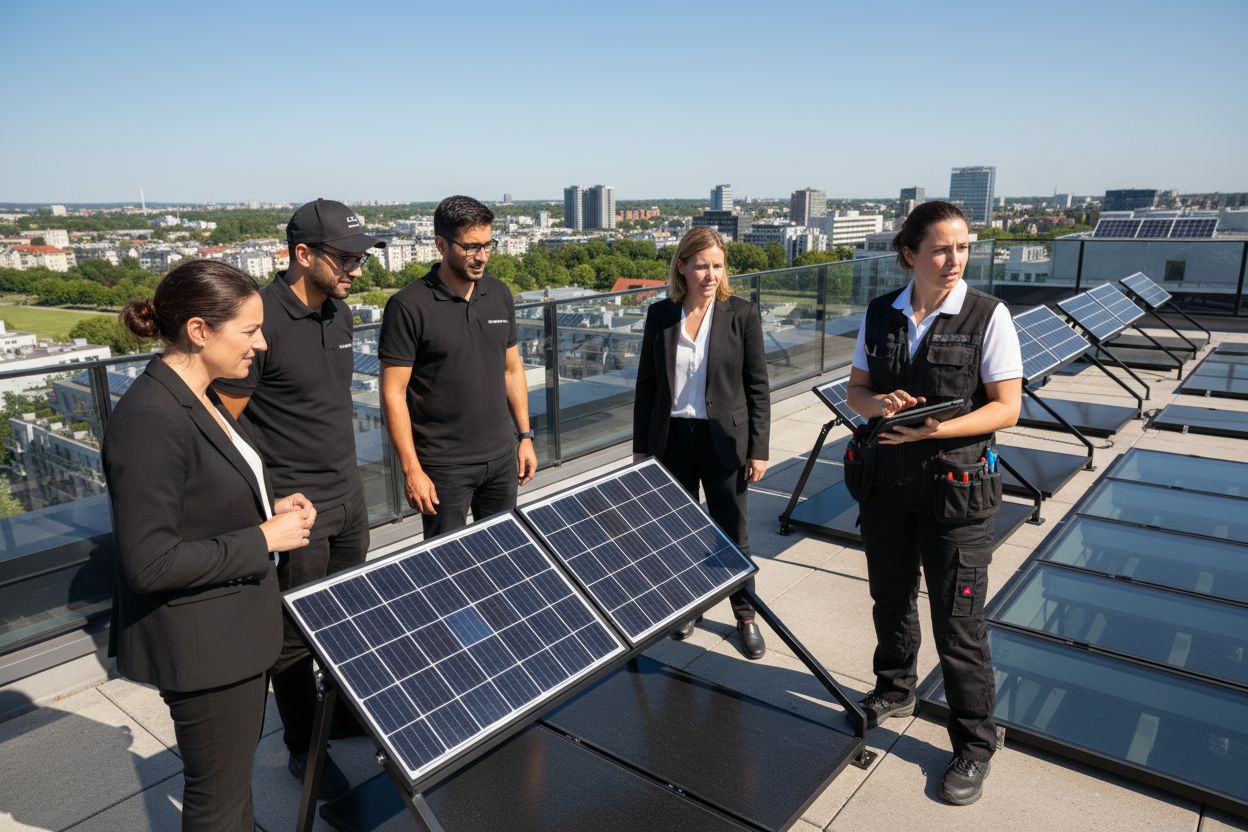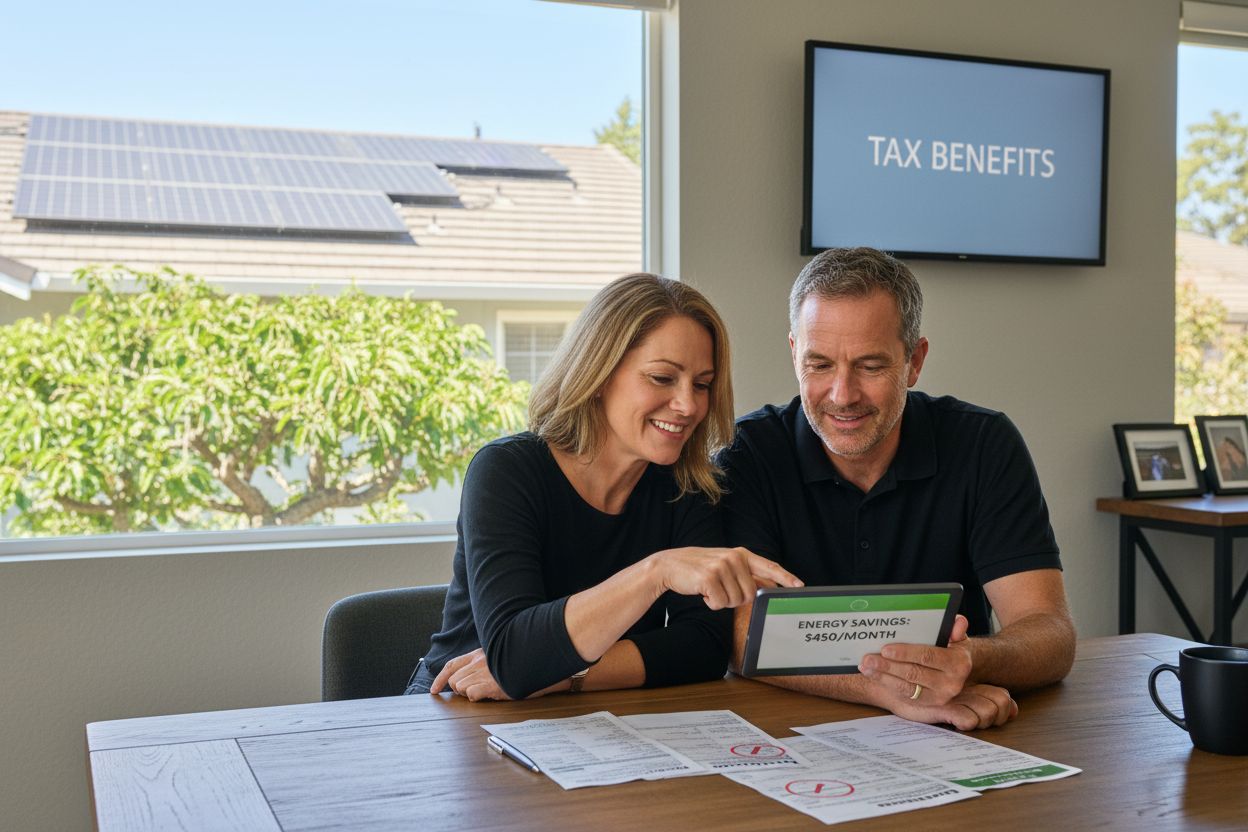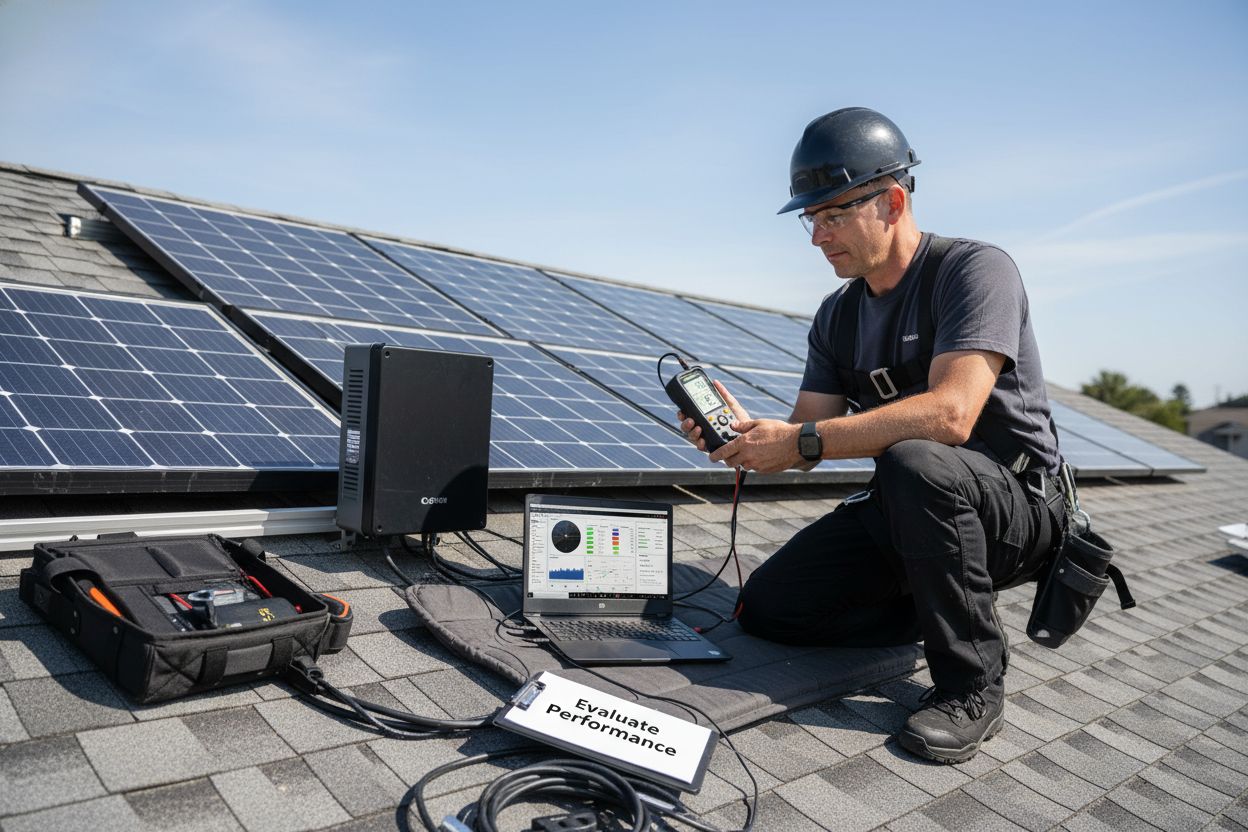
Solar panels are everywhere, from rooftops downtown to vast fields lining highways, and people talk about their power to slash energy bills. But most folks have no clue that solar panels come in wildly different forms and the differences are not just about looks. Some modern solar panels deliver efficiency rates as high as 22 percent while others barely top 7 percent. That means the right panel could double your energy harvest or leave you wasting space. What actually sets these solar technologies apart is not the price tag. It is the hidden details in their design and performance most installers never mention.
Table of Contents
- Understanding Monocrystalline Solar Panels
- Exploring Polycrystalline Solar Panels
- Examining Thin-Film Solar Panels
- Learning About Bifacial Solar Panels
- Unpacking Building-Integrated Photovoltaics (BIPV)
- Evaluating Concentrated Solar Power (CSP)
- Comparing Costs and Efficiency of Solar Panel Types
Quick Summary
| Takeaway | Explanation |
|---|---|
| Monocrystalline panels offer highest efficiency | They typically achieve efficiency rates between 15% to 22%, making them ideal for maximizing energy output. |
| Polycrystalline panels are budget-friendly | With efficiency rates of 13% to 16%, these panels provide cost-effective solar energy solutions without compromising too much on efficiency. |
| Thin-film panels are flexible and lightweight | Their lightweight design and flexibility allow for creative installations on irregular surfaces where traditional panels may not fit. |
| Bifacial panels capture light from both sides | By utilizing both sides for energy generation, they can increase output by up to 30%, especially in reflective environments. |
| BIPV integrates solar into building materials | These systems replace conventional building materials, providing aesthetic and functional benefits while generating energy seamlessly. |
1: Understanding Monocrystalline Solar Panels
Monocrystalline solar panels represent the pinnacle of solar technology, offering exceptional efficiency and sleek design for energy-conscious consumers. These panels are crafted from single-crystal silicon structures, created through a sophisticated manufacturing process that produces the purest form of solar cell technology.
The production of monocrystalline panels begins with a complex method called the Czochralski process, where high-grade silicon is melted and carefully formed into large cylindrical ingots. These ingots are then precisely sliced into thin wafers, creating the distinctive dark black or deep blue appearance that sets these panels apart from other solar panel types. This intricate manufacturing technique results in a more uniform and streamlined panel structure.
Key characteristics of monocrystalline solar panels include:
Highest efficiency rates among solar panel types, typically ranging from 15% to 22%
Longer lifespan, often lasting 25 to 30 years with minimal performance degradation
Superior performance in low-light conditions compared to other solar panel varieties
While monocrystalline panels offer remarkable benefits, they do come with a higher initial investment. According to solar energy research from National Renewable Energy Laboratory, these panels provide the most advanced solar technology currently available in the market. Their premium pricing reflects the sophisticated manufacturing process and superior energy conversion capabilities.
Consumers interested in understanding solar cell technology will appreciate how monocrystalline panels maximize energy production in limited space. Their compact design makes them ideal for residential and commercial installations where roof or ground space is at a premium, delivering exceptional power output relative to their physical footprint.
Despite their higher cost, monocrystalline solar panels remain the top choice for those seeking maximum energy efficiency and a sophisticated, modern aesthetic in their renewable energy solution.
2: Exploring Polycrystalline Solar Panels
Polycrystalline solar panels represent an accessible and cost-effective alternative to their monocrystalline counterparts, offering a practical solution for residential and commercial solar energy systems. These panels are manufactured using a multi-crystalline silicon production method that differs significantly from the single-crystal approach used in monocrystalline panels.
The manufacturing process for polycrystalline panels involves melting multiple silicon fragments together, which are then cooled and formed into distinctive square-shaped wafers. This process creates a characteristic blue speckled appearance with a less uniform surface compared to monocrystalline panels. The multi-crystal structure results in a more budget-friendly solar technology that has gained substantial popularity in the renewable energy market.
Key characteristics of polycrystalline solar panels include:
Lower manufacturing costs making them more affordable for budget-conscious consumers
Efficiency rates typically ranging between 13% to 16%
Moderate temperature performance with slightly reduced efficiency in high-heat environments
According to National Renewable Energy Laboratory research, polycrystalline panels provide a balanced approach to solar energy generation. While they may not match the peak efficiency of monocrystalline panels, they offer a compelling value proposition for many solar installations.
These panels are particularly well-suited for what to know about solar panel installations where space is less constrained and initial cost is a primary consideration. The lower production expenses translate into more accessible solar solutions for homeowners and businesses looking to reduce their energy costs and environmental footprint.
Polycrystalline solar panels continue to evolve, with ongoing technological improvements gradually enhancing their performance and making them an increasingly attractive option in the renewable energy landscape.
3: Examining Thin-Film Solar Panels
Thin-film solar panels represent a revolutionary approach to solar technology, offering unprecedented flexibility and versatility in solar energy generation. Unlike traditional crystalline panels, these innovative solar solutions are manufactured by depositing ultrathin layers of photovoltaic material directly onto various substrates, including glass, plastic, and metal surfaces.
The manufacturing process involves applying extremely thin semiconductor materials such as cadmium telluride (CdTe), amorphous silicon (a-Si), or copper indium gallium selenide (CIGS) in microscopic layers. This unique production technique creates solar panels that are significantly lighter and more adaptable than conventional silicon-based panels, opening up entirely new possibilities for solar energy integration.
Key characteristics of thin-film solar panels include:
Exceptional flexibility allowing installation on curved or irregular surfaces
Lower manufacturing costs compared to traditional crystalline panels
Reduced sensitivity to high-temperature environments
Research from the National Renewable Energy Laboratory indicates that thin-film technologies continue to advance, with efficiency rates progressively improving. While currently less efficient than crystalline panels, these solar solutions excel in specific applications where traditional panels are impractical.
The remarkable adaptability of thin-film panels makes them ideal for how to set up solar panels in unconventional spaces. Their lightweight nature enables integration into building materials, portable devices, and even clothing, transforming how we conceptualize solar energy generation.
Despite lower efficiency rates ranging between 7% to 13%, thin-film solar panels offer unique advantages in scenarios requiring maximum flexibility and minimal weight. Their potential for creative solar implementation continues to drive technological innovation in the renewable energy sector.
4: Learning about Bifacial Solar Panels
Bifacial solar panels represent a groundbreaking innovation in solar technology, offering dual-sided energy generation that dramatically increases potential power output. Unlike traditional single-sided panels, these advanced solar modules can capture sunlight from both their front and back surfaces, creating a more comprehensive and efficient energy collection system.
The unique design of bifacial solar panels involves transparent backsheets or glass backing, allowing reflected and diffused light to be converted into electrical energy. This ingenious engineering means the panels can generate electricity not just from direct sunlight hitting their primary surface, but also from light reflected off the ground or surrounding surfaces.
Key characteristics of bifacial solar panels include:
Enhanced energy generation potentially increasing output by 5% to 30%
Superior performance in reflective environments such as snow-covered ground or light-colored surfaces
Longer operational lifespan due to reduced thermal stress
According to research from the National Renewable Energy Laboratory, bifacial panels demonstrate remarkable potential in optimizing solar energy production. Their ability to capture additional light makes them particularly effective in ground-mounted installations, solar farms, and locations with high albedo surfaces.
The technological versatility of these panels allows for creative installations in various settings. Our comprehensive guide on solar technology types further explores how bifacial panels are transforming renewable energy strategies.
While initially more expensive than traditional solar panels, bifacial technology offers a compelling long-term value proposition. The additional energy generation potential can offset higher upfront costs, making them an increasingly attractive option for both commercial and residential solar installations. As solar technology continues to evolve, bifacial panels represent a significant step toward maximizing renewable energy efficiency.
5: Unpacking Building-Integrated Photovoltaics (BIPV)
Building-Integrated Photovoltaics (BIPV) represent a revolutionary approach to solar technology that seamlessly transforms architectural elements into functional energy-generating surfaces. Unlike traditional solar panel installations, BIPV systems are designed to be an integral part of a building’s structure, replacing conventional building materials with solar-generating components.
This innovative technology enables solar energy generation through materials like roofing tiles, windows, facades, and exterior cladding. The aesthetic and functional integration of solar technology into building design eliminates the need for separate solar panel mounting, creating a more streamlined and visually appealing renewable energy solution.
Key characteristics of Building-Integrated Photovoltaics include:
Dual-purpose functionality as both building material and energy generator
Improved architectural aesthetics compared to traditional solar panel installations
Potential for significant energy cost savings through integrated design
According to research from the National Renewable Energy Laboratory, BIPV technologies are rapidly evolving, with efficiency rates continuously improving. These systems offer architects and builders a powerful tool for creating energy-efficient structures that generate electricity without compromising design integrity.
Our comprehensive guide on solar technology types explores how BIPV is transforming the intersection of architecture and renewable energy. The technology is particularly compelling for new construction projects seeking to incorporate sustainable design principles from the ground up.
While current BIPV systems may have slightly lower efficiency compared to traditional solar panels, their ability to serve multiple purposes makes them an increasingly attractive option. As manufacturing techniques improve and costs decrease, Building-Integrated Photovoltaics are poised to become a mainstream solution in sustainable architectural design, offering a glimpse into a future where buildings are not just structures, but active energy producers.
6: Evaluating Concentrated Solar Power (CSP)
Concentrated Solar Power (CSP) represents a sophisticated approach to solar energy generation that fundamentally differs from traditional photovoltaic technologies. Unlike panel-based systems, CSP utilizes advanced mirror configurations to concentrate sunlight onto a specific receiver, generating immense heat that can be transformed into electrical power through thermal processes.
The technology employs large-scale mirror arrays that track the sun’s movement, focusing solar radiation onto a central collector. These precision-engineered systems can generate extremely high temperatures, allowing for thermal energy conversion that can produce electricity even when direct sunlight is unavailable, making CSP a uniquely versatile renewable energy solution.
Key characteristics of Concentrated Solar Power include:
Ability to store thermal energy for electricity generation during non-sunlight hours
Substantial power generation capacity suitable for utility-scale applications
Reduced dependence on battery storage compared to traditional solar technologies
According to research from the National Renewable Energy Laboratory, CSP technologies offer remarkable potential for large-scale, continuous renewable energy production. These systems are particularly effective in regions with consistent, intense sunlight and significant open terrain.
Exploring the guide to solar savings reveals how CSP can provide substantial long-term economic benefits for utility companies and regional energy infrastructures. The technology’s capability to generate consistent power makes it an increasingly attractive option for regions seeking stable, sustainable energy solutions.
While current CSP installations require significant initial investment and specific geographical conditions, ongoing technological advancements continue to improve efficiency and reduce operational costs. As renewable energy strategies evolve, Concentrated Solar Power stands as a promising approach to meeting global energy demands through innovative thermal conversion technologies.
7: Comparing Costs and Efficiency of Solar Panel Types
Comparing solar panel types reveals a complex landscape of technological innovation, where efficiency, cost, and application play critical roles in determining the most suitable solution for different energy needs. Understanding these nuanced differences can help consumers and businesses make informed decisions about their solar investments.
The spectrum of solar panel technologies presents distinct trade-offs between performance and economic feasibility. Monocrystalline panels, while offering the highest efficiency rates of 15-22%, also command the highest price points. Polycrystalline panels provide a more budget-friendly alternative, with efficiency rates between 13-16% at a significantly reduced cost, making them attractive for price-sensitive installations.
Key considerations when comparing solar panel technologies include:
Initial installation costs versus long-term energy generation potential
Performance degradation rates for different panel types
Geographical and environmental suitability of specific solar technologies
According to research from the National Renewable Energy Laboratory, the total cost of ownership extends far beyond initial purchase price. Thin-film panels, despite lower efficiency rates of 7-13%, offer unique advantages in flexibility and lightweight design that can offset their reduced energy generation in specific applications.
Understanding the guide to solar savings demonstrates that advanced technologies like bifacial and BIPV panels can generate additional energy through innovative design, potentially compensating for higher upfront investments.
Building-Integrated Photovoltaics (BIPV) and Concentrated Solar Power (CSP) represent more specialized solutions with higher implementation costs but potentially superior long-term value in specific contexts. The most effective solar strategy depends on individual energy requirements, geographical location, available installation space, and budget constraints, underscoring the importance of comprehensive technological evaluation before making a solar investment.
Below is a comprehensive table summarizing the key types of solar panels, their main characteristics, benefits, and suitable applications as discussed throughout the article.
| Solar Panel Type | Key Characteristics | Typical Efficiency | Main Benefits | Ideal Applications |
|---|---|---|---|---|
| Monocrystalline | Single-crystal silicon, uniform, dark appearance | 15%-22% | Highest efficiency, long lifespan, compact size | Limited space, high-output systems |
| Polycrystalline | Multi-crystal silicon, blue speckled look | 13%-16% | Affordable, easier production, moderate efficiency | Budget-friendly, less space constraints |
| Thin-Film | Flexible, lightweight, deposited on various materials | 7%-13% | Bendable, installs on irregular surfaces, lightweight | Large areas, portable & unconventional use |
| Bifacial | Captures light from both front and back surfaces | +5-30% over standard | Increased energy yield, great in reflective environments | Ground mounts, high-albedo surfaces |
| Building-Integrated Photovoltaics (BIPV) | Integrated in building materials: roofs, facades, windows | Slightly lower than mono/poly | Dual function (structure + energy), aesthetic integration | New construction, design-conscious builds |
| Concentrated Solar Power (CSP) | Uses mirrors/lenses to focus sunlight for heat generation | N/A (not PV based) | Large-scale power, stores thermal energy | Utility-scale, sunny open terrain |
| Cost & Efficiency Comparison | Trade-off between price, efficiency, and application | Varies by type | Choice depends on site, goals, space, budget | Residential, commercial, utility |
Ready to Find the Perfect Solar Panel Solution?
Choosing the right solar panel can feel overwhelming, especially when faced with so many options like monocrystalline, polycrystalline, thin-film, and advanced features such as bifacial and BIPV. This article highlights the challenges of comparing technology, efficiency, price, and long-term benefits. If you are struggling to decide which solar panel type truly meets your needs or want to avoid costly mistakes in your green energy journey, you are not alone. Start your search with trusted resources and expert guidance.

Discover more hands-on insights and find unbiased reviews tailored to your solar needs. Visit our Product Reviews section for detailed analyses of the latest solar innovations, and explore how HTEXS makes solar technology simple and accessible. Do not wait while energy prices rise. Take action now to confidently choose the right solar solution for your home or business.
Frequently Asked Questions
What are the main types of solar panels I need to know about?
Monocrystalline, polycrystalline, thin-film, bifacial, building-integrated photovoltaics (BIPV), and concentrated solar power (CSP) are the primary types of solar panels. Each type varies in terms of efficiency, cost, and application, so understanding these differences is essential for making an informed choice.
How do monocrystalline solar panels compare to polycrystalline panels?
Monocrystalline solar panels typically have higher efficiency rates of 15% to 22%, while polycrystalline panels range from 13% to 16%. Consider your space and budget; if efficiency is a priority, opt for monocrystalline panels, but if cost-effectiveness is key, explore polycrystalline options.
What advantages do thin-film solar panels offer?
Thin-film solar panels are lightweight, flexible, and can be installed on irregular surfaces. To take advantage of their unique benefits, review your project requirements and consider thin-film for applications where space or weight restrictions exist.
Why should I consider bifacial solar panels?
Bifacial solar panels can generate electricity from both sides, potentially increasing power output by 5% to 30%. Evaluate your installation location for reflective surfaces to maximize the additional power generation these panels can provide.
How can Building-Integrated Photovoltaics (BIPV) enhance my home or building design?
BIPV systems combine architectural elements with solar technology, allowing for energy generation without compromising aesthetics. If you are designing a new building or undergoing renovations, investigate BIPV options to integrate renewable energy seamlessly into your design.
What is the potential of Concentrated Solar Power (CSP) systems?
CSP systems are designed for large-scale applications and can store thermal energy for electricity generation during non-sunlight hours. For utility-scale projects, assess your needs and consider CSP for its substantial power generation capacity.






